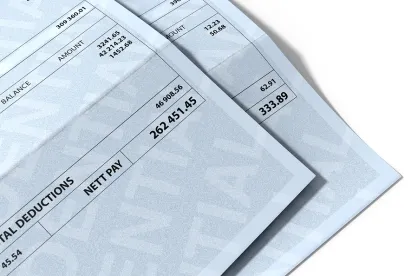Updated April 6, 2020
On March 27, 2020, the President signed the Coronavirus Aid, Relief, and Economic Security (CARES) Act (the “Act”) into law following the Act’s approval by both chambers of Congress. The Act amends Section 7(a) of the Small Business Act to include a new guaranteed, unsecured loan program (the “Paycheck Protection Program”). The Paycheck Protection Program is an expansion of the Small Business Administration (the “SBA”) Economic Injury Disaster Loan program. The program provides for $349 billion to support loans to a broader segment of small businesses than those that would otherwise be eligible to receive SBA 7(a) loans. The key terms of the existing program and the related modifications are as follows:
Traditional SBA 7(a) Program
The Small Business Administration's 7(a) Loan Program is designed to provide financial assistance to small businesses. The SBA does not offer these loans itself but instead uses a network of SBA-approved lenders nationwide.
Loan Terms. For traditional SBA 7(a) loans, the borrowing maximum is $5 million. For loans up to $150,000, the SBA guarantees 85%. For loans greater than $150,000, the SBA guarantees 75%. The repayment terms are between 5-7 years for working capital, up to 10 years for business acquisition and equipment, and up to 25 years for real estate purchase or construction. The interest rate is usually negotiated between the borrower and the lender, but cannot exceed the SBA maximum interest rate. Prepayment penalties may apply. Processing fees, origination fees, application fees, points, brokerage fees, bonus points and other fees are prohibited. A personal guarantee is required from any 20% owner of the small business. There are no collateral requirements for loans of up to $25,000. For loans in excess of $350,000, the lender must collateralize the loan to the maximum extent possible up to the loan amount.
Permissible Purposes. SBA loan proceeds generally may be used only for a “sound business purpose.” Certain uses are prohibited, including: payments, distributions or loans to associates of the applicant (except for ordinary compensation for services rendered); investments in real or personal property acquired and held primarily for sale, lease, or investment (subject to certain exceptions); or the payment of federal or state taxes. The proceeds of Section 7(a) loans may not be used to pay any creditor in a position to sustain a loss causing a shift to SBA of all or part of a potential loss from an existing debt, or to purchase a portion of a business or a portion of another owner's interest.
SBA Borrower Eligibility Requirements. A borrower must meet the SBA’s small business “size” standards, which vary by the NAICS code of the particular borrower. These size standards take into consideration the borrower’s annual receipts (i.e., revenues) and/or number of employees. Depending on the applicable NAICS code, the maximum receipts can be as low as $1MM and the maximum number of employees can be as few as 100.
In addition, the small business must:
-
Operate on a for-profit basis;
-
Currently do business in the U.S. or its territories, or plan to do so;
-
Be able to invest reasonable owner equity (new businesses should have $1 of cash or business assets for each $3 of the loan, while established businesses should have at least $1 for every $4 of the loan); and
-
Use personal assets and other financial resources before applying for assistance.
Certain businesses are ineligible for SBA Section 7(a) loans, including but not limited to:
-
Non-profit businesses (for-profit subsidiaries are eligible);
-
Financial businesses primarily engaged in the business of lending, such as banks, finance companies, and factors (pawn shops, although engaged in lending, may qualify in some circumstances);
-
Passive businesses owned by developers and landlords that do not actively use or occupy the assets acquired or improved with the loan proceeds (except Eligible Passive Companies under §120.111);
-
Life insurance companies;
-
Businesses located in a foreign country (businesses in the U.S. owned by aliens may qualify);
-
Loan packagers earning more than one third of their gross annual revenue from packaging SBA loans;
-
Businesses primarily engaged in political or lobbying activities; and
-
Speculative businesses (such as oil wildcatting).
SBA provides business loan assistance only to applicants for whom the desired credit is not otherwise available on reasonable terms from non-Federal sources. The lender must certify or otherwise show that the desired credit is unavailable to the applicant on reasonable terms and conditions from non-Federal sources without SBA assistance, taking into consideration the prevailing rates and terms in the community in or near where the applicant conducts business, for similar purposes and periods of time.
SBA Affiliation Standards. For purposes of determining borrower eligibility under the size standards, the SBA has adopted affiliation standards. Entities deemed affiliated with the borrower are aggregated with the borrower for purposes of applying the SBA’s receipts and employee tests. Affiliation is determined based on the existence of “control,” although the SBA’s concept of “control” differs from concepts used by other government agencies, such as the banking regulators. Generally speaking, for SBA purposes, affiliation is deemed to exist at the 50% ownership or common ownership level and affiliation may arise where one or more officers, directors, managing members, or partners who control the board of directors and/or management of one concern also control the board of directors or management of one or more other concerns, but the SBA’s affiliation standards take into account a variety of other factors and each situation should be reviewed individually.
SBA Approved Lender Criteria. To be an eligible lender, a lender must apply to the SBA through one of the SBA local offices and be approved.
-
Have a continuing ability to evaluate, process, close, disburse, service, and liquidate small business loans;
-
Satisfy SBA capital requirements (for bank lenders, compliance with bank regulatory capital suffices);
-
Be open to the public to issue loans (and not be a financing subsidiary, engaged primarily in financing the operations of an affiliate);
-
Have continuing good character and reputation, and otherwise meet and maintain the ethical requirements as identified in SBA regulations (13 CFR §140); and
-
Be supervised and examined by a state or federal banking agency (in the case of a bank), or by the SBA itself.
SBA lenders are required to maintain a satisfactory level of SBA operating performance (e.g., default rates, loan volumes, etc.) based on standards adopted by the SBA.
SBA Secondary Market Transactions. SBA regulations limit the transferability of SBA 7(a) loans. With the prior approval of the SBA, the guaranteed portion of the loans may be transferred, sold, or assigned to another SBA participating lender (along with a “Guaranteed Interest Certificate” indicating the SBA’s guarantee of principal and interest on the loan). Settlement is effected via a Bank of New York subsidiary, Colson. Transfer is accomplished by filling out an SBA Form 1086 (signed by all parties) and submitting that via Colson, as the Fiscal and Transfer Agent (FTA), along with a certified copy of the borrower’s note.
The guaranteed portion of SBA loans (in this case, 100%) can also be sold in the secondary market as loan pools with a “Guaranteed Loan Pool Certificate.” Under the terms of the Guaranteed Interest Certificate, the SBA guarantees the payment of principal and interest on the loan underlying the Certificate. The SBA will pay principal and interest on the loan up through the date of payment by the SBA. In this form, payment of principal and interest up to the time of payment is guaranteed by the SBA which is backed by the full faith and credit of the United States, but such payment is not guaranteed as to timeliness.
In addition, the guaranteed portion of SBA can also be assembled by so-called SBA 7(a) approved “Loan Pool Assemblers.” The SBA and Colson both maintain a list of such assemblers on their websites. These pools are retained by the Loan Pool Assemblers with the original lender acting as servicer and Colson (the FTA) acting as collateral bank and paying agent. The SBA will issue to each investor in the pool a fractional Guaranteed Loan Pool Certificate, which represents the SBA’s guarantee of the timely payment of principal and interest on the loans underlying the Pool Certificate. The SBA will pay principal and interest on the loans underlying the Pool Certificate through the date of payment by the SBA, with such payments guaranteed as to timeliness. These Certificates are liquid and may be held by a wide range of investors, not just SBA licensed 7(a) lenders.
SBA Section 7(a) loans may be pledged with the prior consent of the SBA, but no prior consent is required to pledge the loan to a Federal Reserve Bank in connection with a Federal Reserve financing program (such as TALF). SBA Section 7(a) loans can be securitized by an SBA lender subject to certain restrictions.
The SBA Section 7(a) Paycheck Protection Program
The CARES Act’s Paycheck Protection Program (PPP) will be offered under the auspices of the Section 7(a) program authority, with some differences from the traditional SBA 7(a) program. In this regard, a PPP loan is intended to enable eligible small business borrowers to keep their workers on the payroll.
Key differences between the PPP and the standard 7(a) SBA loan program are as follows:
-
The PPP maximum loan amount is increased from $5 million to $10 million during the "covered period," which is from February 15, 2020 through June 30, 2020. The maximum value of a company's loan will be an amount equal to the lesser of (i) $10 million and (ii) 2.5x of the average monthly payroll cost in 2019. This includes employee wages and benefits.
-
Under the PPP, the SBA temporarily guarantees 100% of the loans, regardless of size. As set forth above, loans up to $150,000 were 85% guaranteed by the SBA, while loans greater than $150,000 were 75% guaranteed by the SBA.
-
Under the PPP, loans are available to any small business with less than 500 employees (including sole proprietorships, independent contractors and self-employed persons), private non-profit organizations or 501(c)(19) veterans organizations. In addition, employers with more than 500 employees are eligible for PPP loans if the employer otherwise satisfies the SBA’s small business size standards. The SBA website also states that food and hospitality employers with multiple locations may be eligible if the locations employ less than 500 employees.
-
Under the PPP, loan terms will be two years, with an interest rate of 1%. Interest will be deferred for the first six months.
-
For PPP loans, the requirement that businesses show they cannot obtain credit elsewhere is waived.
-
The annual or guarantee fees for the loan and all prepayment penalties is not applicable. As set forth above, prepayment penalties applies in certain circumstances for PPP loans.
-
For PPP loans, the SBA has indicated that it plans to have a process in place by which loans can be made and disbursed in the same day. SBA guidelines state that it usually takes five to 10 business days.
-
With respect to PPP loans, businesses will not need to provide a personal guarantee or collateral. As set forth above, lenders will not require collateral for loans up to $25,000. For loans in excess of $350,000, the SBA traditionally requires that the lender collateralize the loan to the maximum extent possible up to the loan amount--and that may include requiring a person to secure his or her loan with personal assets.
-
For PPP loans, the SBA is expanding the permitted use of funds to explicitly include payroll support, paid sick leave, mortgage payments, rent payments, and servicing existing debt. However, 75% of the PPP loan proceeds must be used for payroll purposes.
The SBA also released new, somewhat relaxed “affiliation” guidance applicable solely to PPP loans. The new guidance eliminates some of the less objective, more cumbersome standards for determining affiliation in connection with a 7(a) loan.
The SBA will forgive PPP loans if all employees are kept on the payroll for eight weeks and the money is used for payroll, rent, mortgage interest, or utilities. The loan will be fully forgiven if the funds are used for payroll costs (and at least 75% of the forgiven amount must have been used for payroll), interest on mortgages, rent, and utilities. PPP loan payments of principal, interest, and fees will also be deferred for six months (but not more than one year). Forgiveness is based on the employer maintaining or quickly rehiring employees and maintaining salary levels. Forgiveness will be reduced if full-time headcount declines, or if salaries and wages decrease.
FDIC-insured depository institutions are automatically eligible to participate in the PPP upon filing a notice with the SBA.






 />i
/>i

